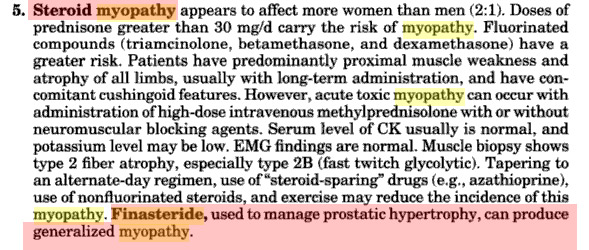RAPIDLY REVERSIBLE MYOPATHY RELATED TO FINASTERIDE THERAPY
F. Giannini, N. Volpi*, G. Bibbò, G. Greco, C. Alessandrini*, L. Flori°, M. Fimiani°
PDF: bio.unipd.it/bam/PDF/14-2/pr … ngress.pdf
(search for “Finasteride” in the PDF)
A seventy-three year-old man, admitted to dermatological ward for evaluation of erythematous-papular-desquamative skin lesions, was referred to neurologist because of three months lasting progressive muscle weakness and atrophy, with 10 kg body weight loss.
Physical examination revealed severe weakness (MRC 3/5) in proximal districts of limbs confirmed by clear EMG myogenic pattern and mild active denervation in proximal muscles.
Leukopenia, increase of serum inflammatory markers and myoglobin, autoantibody titers and muscle enzyme values within normal range were observed. Skin biopsy was consistent with discoid lupus erythematosus, whereas muscle biopsy showed atrophy of type II fibers, mild type grouping and no inflammatory changes.
The patient had been treated with finasteride 5 mg/die for five years because of benign prostatic hyperplasia and never had used corticosteroids. Owing to similarity of clinical findings with a previously described case, the drug was withdrawn (Haan, 1997).
One month later, recovery of muscle strength was remarkable and body weight had increased by 3 kg. Antiandrogen finasteride, a 5-alpha-reductase inhibitor, is employed in benign prostatic hyperplasia and alopecia.
Sexual dysfunctions are most frequent side effects, whereas abdominal-pelvic pain, headache and asthenia are rarely reported.
The current case confirms rapidly reversible myopathy as a possible adverse effect of finasteride treatment, attributable to its structural affinity to corticosteroids.

